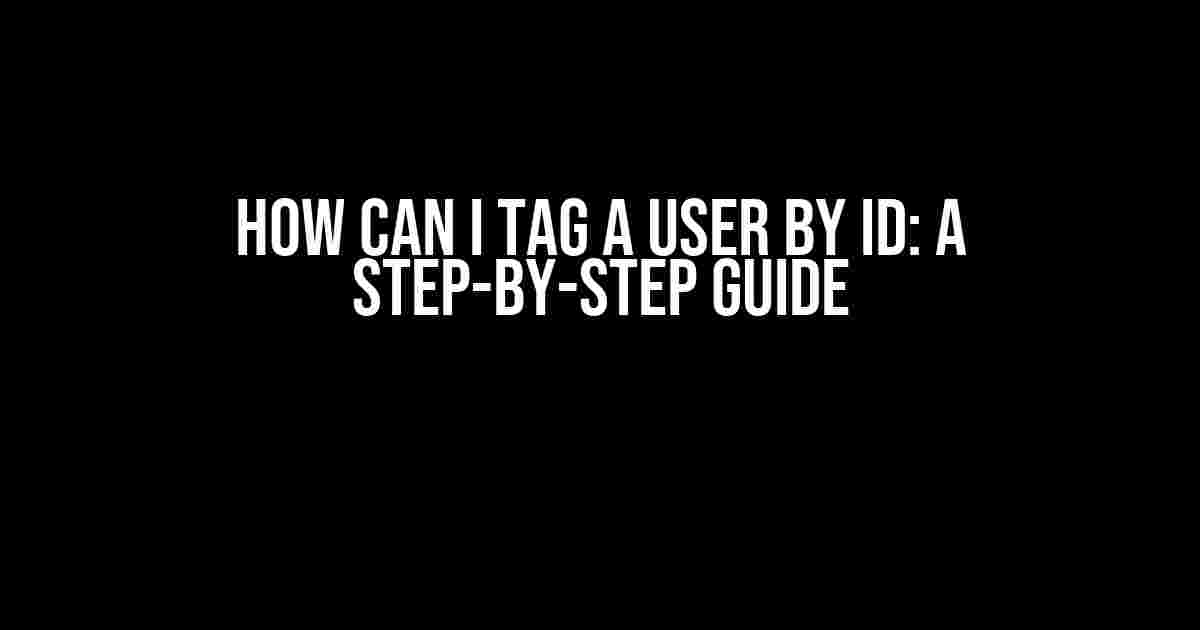Are you tired of searching for users by their usernames or names? Do you want to tag users quickly and efficiently by their unique IDs? Look no further! In this comprehensive guide, we’ll show you how to tag a user by ID in various platforms and programming languages.
What is User ID?
A user ID, also known as a user identifier, is a unique string of characters assigned to each user in a system, platform, or application. It’s used to identify and distinguish one user from another. User IDs can be numerical, alphabetical, or a combination of both.
Why Tag Users by ID?
Tagging users by ID has several benefits, including:
- Efficient searching: Quickly find and tag users by their IDs, saving time and effort.
- Unique identification: IDs are unique to each user, reducing errors and ambiguity.
- Platform independence: IDs work across different platforms and systems, making it a versatile solution.
- Better data organization: Organize user data more effectively using IDs, making it easier to analyze and process.
Tagging Users by ID in Social Media Platforms
Many social media platforms allow you to tag users by their IDs. Here’s how to do it on some popular platforms:
To tag a user by ID on Facebook, use the following format:
@[@username](fb://profile/[user_id])
Replace [username] with the user’s username and [user_id] with their unique ID.
On Twitter, you can tag a user by ID using the following format:
@[@username](https://twitter.com/[user_id])
Replace [username] with the user’s username and [user_id] with their unique ID.
Instagram allows you to tag users by ID using the following format:
@[@username](https://www.instagram.com/[user_id])
Replace [username] with the user’s username and [user_id] with their unique ID.
Tagging Users by ID in Programming Languages
In programming languages, you can tag users by ID using various methods and libraries. Here are some examples:
JavaScript
In JavaScript, you can use the Facebook SDK to tag users by ID:
FB.api('/[user_id]', function(response) {
console.log(response);
});
Replace [user_id] with the user’s unique ID.
Python
In Python, you can use the Facebook SDK to tag users by ID:
import facebook
graph = facebook.GraphAPI(access_token)
user = graph.get_object('[user_id]')
print(user)
Replace [user_id] with the user’s unique ID and [access_token] with a valid access token.
Java
In Java, you can use the Facebook SDK to tag users by ID:
FacebookClient facebookClient = new DefaultFacebookClient();
User user = facebookClient.fetchObject("[user_id]", User.class);
System.out.println(user);
Replace [user_id] with the user’s unique ID.
Common Issues and Solutions
When tagging users by ID, you may encounter some common issues. Here are some solutions:
| Issue | Solution |
|---|---|
| Invalid user ID | Check the user ID for formatting errors or typos. Make sure it’s a valid and existing ID. |
| User not found | Verify that the user exists on the platform or system. Check for spelling mistakes or incorrect IDs. |
| Platform restrictions | Check the platform’s documentation for any restrictions on tagging users by ID. Some platforms may have specific rules or requirements. |
Best Practices for Tagging Users by ID
To get the most out of tagging users by ID, follow these best practices:
- Use unique and valid IDs to avoid errors and ambiguity.
- Verify user existence and permissions before tagging them.
- Use the correct formatting and syntax for each platform or system.
- Respect user privacy and permissions when tagging them.
- Test and validate your code or method to ensure it’s working correctly.
Conclusion
Tagging users by ID is a powerful and efficient way to identify and interact with users across various platforms and systems. By following the instructions and best practices outlined in this guide, you’ll be able to tag users by ID like a pro. Remember to respect user privacy and permissions, and always verify user existence and IDs to avoid errors.
Now that you know how to tag users by ID, go ahead and start exploring the possibilities! Whether you’re a developer, marketer, or social media enthusiast, tagging users by ID will take your interactions to the next level.
Here are the 5 Questions and Answers about “How can I tag a user by id” in a creative voice and tone:
Frequently Asked Question
Got a question about tagging a user by ID? You’re in the right place! Here are some frequently asked questions and answers to help you out.
Can I tag a user by ID without any third-party plugins?
Yes, you can! Most social media platforms and online communities allow you to tag users by their ID without needing any third-party plugins. Just make sure you have the correct ID and the platform’s tagging syntax is enabled.
What is the correct syntax for tagging a user by ID?
The syntax varies depending on the platform, but most commonly, you’ll need to use the “at” symbol (@) followed by the user’s ID. For example, @123456789. Check the platform’s documentation for specific instructions.
Can I tag a user by ID in a private message?
Yes, most platforms allow you to tag users by ID in private messages as well! Just use the same syntax as you would in a public post, and the platform will notify the tagged user.
How do I find a user’s ID if I don’t have it?
That’s a great question! You can usually find a user’s ID by checking their profile URL or by using the platform’s built-in search function. Some platforms also provide a “Get ID” or “Copy ID” feature on the user’s profile page.
Is there a limit to how many users I can tag by ID in a single post?
Yes, most platforms have a limit to how many users you can tag by ID in a single post. This limit varies depending on the platform, but it’s usually around 10-20 users. Exceeding this limit may result in an error or your post being flagged for spam.

